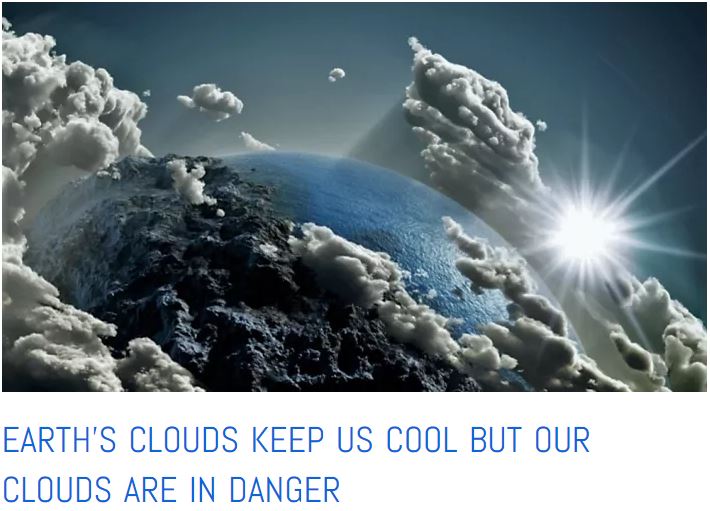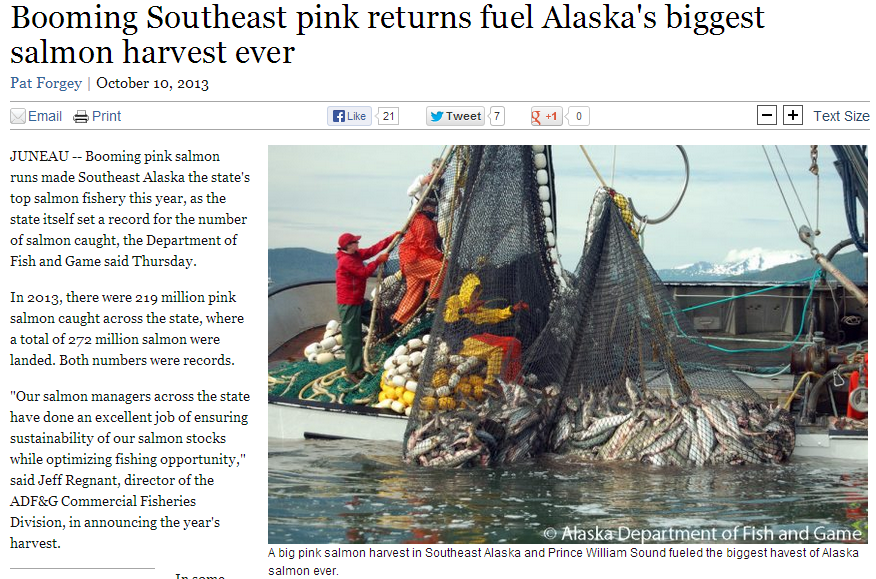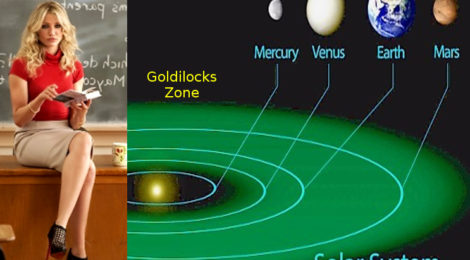
Goldilocks Bears All About Global Warming
Do you remember the story of Goldilocks and the Three Bears?
Goldie’s dilemma and ours is how do we find what we need that is not too hot, not too cold, but just right.
Earth is really very much on the inside of our Solar System’s Goldilocks Zone and almost too hot for life. Fortunately, Nature cleverly evolved the power to keep our blue planet cool by creating ocean plants with the ability to make cooling clouds.
But there is trouble brewing among our clouds and we’d better do what we surely can to help with that trouble.
Recently astrophysicists have revised old models that have recast our solar systems Goldilocks Zone and the revisions go a long way to redefining how we understand the emergence and evolution of life here on our own blue Earth. As it turns our planet lies far too close to our sun for comfort and for life to have emerged, evolved, and remain sustainable here. It has taken Nature’s best efforts to make our world comfortable for us. (Hint- We might need to help.)
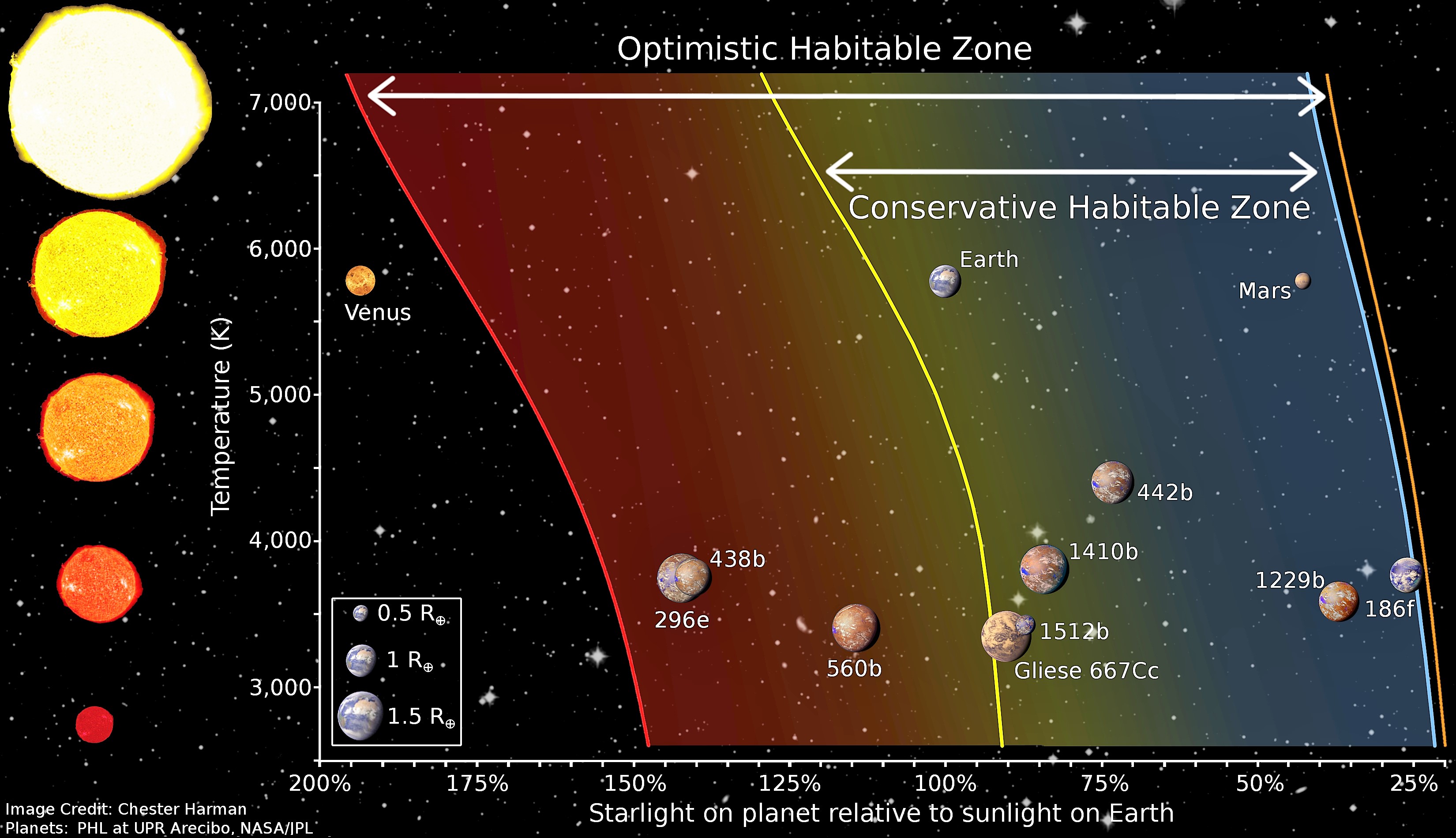
This newly revised Goldilocks Zone fixed key model flaws and overturns the old overly optimistic zone, the present more conservative zone places our Blue Earth far too close for comfort to the hot side of the zone! – click to enlarge
How life finds a way
It seems that every year the world of science unveils more and more secrets of how life on our water world has emerged, thrived, and survived. In some 4 billion years of continuous evolution, life has emerged from primitive forms that likely lived deep in the primordial seas evolving the ability to extract pure energy, electrons, from hot atoms associated with deep-sea hot springs, hydrothermal vents. Only after eons of time did those first electron eating microbes evolve the ability to consume each other and become bacteria, with more eons of time those bacteria drifted to the surface and evolved the ability to survive in the blistering sunlight and even harvest some of that sunlight as their source of energy. Thus were born the first phytoplankton, first the blue-green algae, aka cyanobacteria, then the true green phytoplankton.
Given the powerful rays of the sun which we all know will give us a terrible sunburn if we lie in it all day long the plankton had to find, and make, their own form of sunscreen. What worked were the natural gases they produced harvesting energy from the sun, it seems all life on this planet is more than a little gassy.
Here’s a short lesson on the biology of ocean plankton, it starts with A of the ABC’s, A is for Albedo.
Most of us have heard that in our own human biology we are said to be 70% water. Well for plankton and algae they are 90-98% water! As they are simple bags of water the chemicals they make, those gassy aerosols are very much water chemicals and most dissolve into the ocean, but some are a bit more resistant to water and make it into the air. There those natural biological molecules of gas still are very much attracted to water and water to them so they naturally become the heart of every raindrop and bit of cloud. Therein lies evolution and Nature’s greatest accomplishment on our blue world that is far too close to the sun for comfort. Life has found/invented/evolved a way to make cooling clouds.
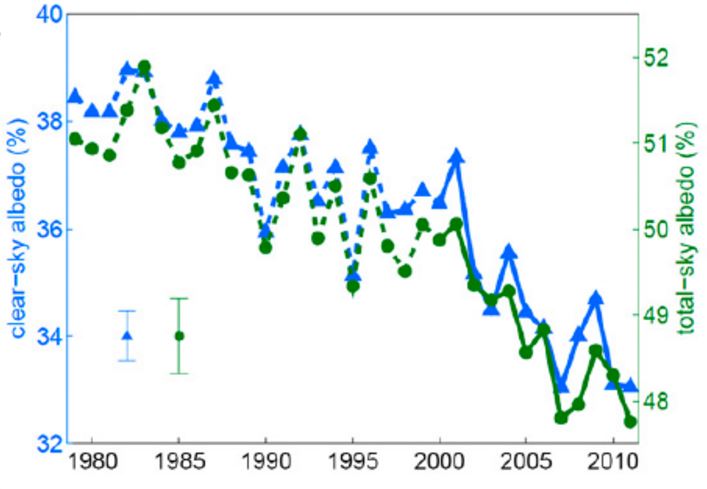
Collapse of albedo/cloudiness is in lockstep with collapse of ocean pastures and their cloud producing plankton blooms.
Albedo is a measure of cloudiness. Diving into the data is an interesting exercise it shows a loss of albedo of 4% in the past 40 years, reports put this as equal to 2W/m2 This value is significant, compared to the GHG forcing for all greenhouse gas emissions over the last century which is estimated to be just 2.4W/m2! Clouds are what keep us cool, thanks to plankton. A change of just 1% to the Earth’s albedo has a radiative effect of 3.4 Wm2, comparable to the forcing from a doubling of CO2.
Alarm – the loss of albedo since 1980 looks to be nearly 4%! Do the math! Restoring cloudiness, and most importantly of all low marine clouds, is our only hope! Ocean Pasture Restoration has the potential to restore albedo equivalent to removing between 4 billion tonnes of CO2 from the air every year OR virtually the entire global warming effect.
Lessons from a Goldilocks who became too hot and one who became too cold.
Venus was once a planet with a warm plankton filled ocean and habitable surface temperatures for up to two billion years. In our evolving solar system our Venusian sister found herself on the too hot side of the Goldilocks Zone, Mars the too cold sister. We should learn from the suffering of our sister planet Venus, lest we follow her path.
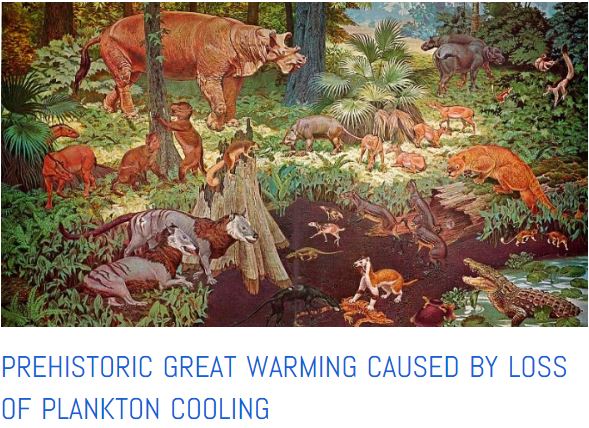
Paleocene/Miocene Great Warming resulted from the mass extinction of many ocean phytoplankton and the disappearance of their cooling clouds – click to read more
Earth, our Blue Planet, is in terrible peril – We Can and Must Help
As much as it may seem that life here is all good, our world has episodically gone through very hard times as seen by repeated mass extinctions some of which were brought on by the collapse of planetary cooling. There is sound fossil evidence for 5 terrible mass extinction events on Earth in the past few billion years. Many scientists today are amassing evidence for our present epoch being declared to be in the beginning of a 6th great dying.
Plant life in the oceans, the phytoplankton, has been in cataclysmic decline for at least 50 years based on real observations, not fuzzy climate models. The rate of phytoplankton/chlorophyll decline is ‘conservatively’ reported at being 1% per year. Ocean plankton produce molecules (aerosols) that make clouds that shade the ocean and reflect sunlight back into space (albedo).
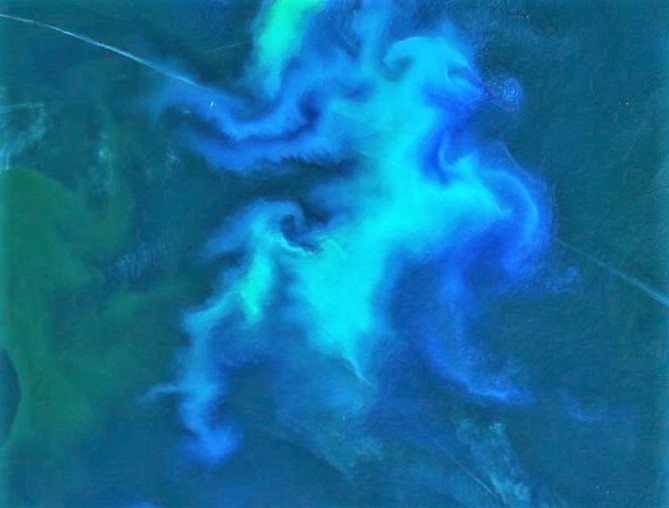
This spectacular plankton bloom near the Shetland Islands as seen from Satellites June 2016 and others like it are the most powerful and important force of nature on our Blue Planet – click to enlarge
Disappearing plankton means fewer clouds and greater ocean warming. This observation is a perfect fit to explain global ocean warming. (Note: Ocean temperature is the most powerful factor in global warming models.)
To put that ocean plankton peril of 1% collapse each year into context one is reminded that the oceans cover 72% of this blue planet. And that doesn’t mean the remaining 28% of the planet is covered with green plants, in reality, less than 15% of the ‘earth’ supports and sustains grass and their taller but rarer cousins, trees. 99% of life on “Earth” lives in the oceans.
The world shares and shows great alarm at the loss of 20% of Amazon plant biomass while neglecting 50 times that amount of ocean plant life that we have eradicated. From a terrestrial point of view, this loss of plant biomass in the oceans is equal to losing an entire Amazon Rainforest every 5 years, that’s 10 Amazon’s gone in the past 50 years in a world that shows great concern about the loss to date of 20% of the actual earth-bound Amazon.
Here’s What We Must Do To Avoid Disaster
Restoring Ocean Plankton Pastures: It Just Works!
The simple fact is that the oceans have become and are becoming ever more desolate blue deserts. This is happening because the vital mineral micro-nutrients they require for their ocean pasture grass to grow, their phytoplankton, is missing as dust in the wind has been drastically reduced due to global greening effects of our high and rising CO2. This high CO2 has produced dramatic global greening and as we all know green stuff covers the ground… so here’s an easy meme to remember…
More grass growing means less dust blowing (follow this link to read more).
We must return and replenish the mineral-rich dust our fossil fuel age has denied the ocean pastures. As we do this they return immediately to historic health and abundance. Fortunately, this takes just a fraction of the time it has taken our industrial age to create the global CO2 crisis.
By restoring ocean plankton cooling capacity to recent levels of health and abundance we will save our world at a cost of mere millions per year instead of the trillions of planned ‘carbon taxes’ to say nothing of the collapse of modern technological societies. Of course, this regeneration of the largest part of Nature, the 72% that is oceans, at such low-cost is anathema to those seeking their share of the trillion-dollar per year terrestrial solutions that cannot cure the crisis. Ces’t la vie.
The ocean solution it turns out is perfectly safe, sustainable, fast, and incredibly low-cost – I like to say it is ‘dirt cheap’ as dirt is the single magic dust that the oceans are dying for lack of. Restoring the oceans will also bring back the fish.
Regenerating ocean pastures in the World’s Seven Seas will mean billions of additional fish will every year fill fishermen’s nets to overflowing – providing sufficient food to help end world hunger. When ocean pastures return to health and abundance it takes only a few years, 2-5, for these billions of additional fish to be providing nutritious food for all.
The cost will be a scant few millions of dollars per year, easily affordable by the just a very few of we common people. The ocean pastures will return to historic health and abundance when, with our help, they repurpose billions of tonnes of CO2 into fresh ocean life, that is the simple scientific fact of photosynthesis.
IT JUST WORKS!
Here’s a photo (below) that speaks a thousand words. In 2012 with just 10 shipmates I took a modest fishing boat out to sea in the NE Pacific. We carefully spread 100 tonnes of mineral dust on a dying ocean pasture. The cost of that blessed dust is less than $50,000 (fifty thousand dollars). The ocean pasture turned from being a blue desert into a lush green pasture. The very next year the fish came back, hundreds of millions of additional salmon.









